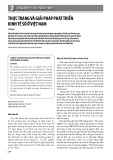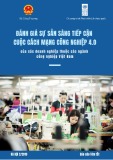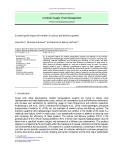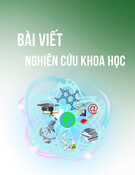
VNU Journal of Economics and Business, Vol. 4, No. 6 (2024) 115-124
115
Original Article
The impact of gamification factors on the continuous
usage intention of Momo e-wallet users in Hanoi
Hoang Trong Truong, Nguyen Trung Luong*
VNU University of Economics and Business
No. 144, Xuan Thuy Road, Cau Giay District, Hanoi, Vietnam
Received: October 09, 2024
Revised: December 06, 2024; Accepted: December 25, 2024
Abstract: Gamification is increasingly being applied to mobile applications, including e-wallets, to
create a more interactive and engaging user experience. As a growing number of financial
applications incorporate gamification elements to encourage customer usage, it becomes essential
to understand the impact of gamification features in this domain. To explore this phenomenon, this
study draws on the Stimulus-Organism-Response (SOR) framework to investigate how gamification
features influence the continuous usage intention of users through enjoyment. An online
questionnaire was designed to collect data from 151 Momo e-wallet users who had experience with
gamified e-wallet applications. Partial Least Square Structural Equation Modeling (PLS-SEM) was
utilized to validate the proposed research model. The results show that Social Interaction,
Competition, Ease of Use and Rewards positively affect Enjoyment, which in turn leads to
Continuous Usage Intention. The research results are consistent with previous findings and confirm
the validity of the SOR framework. Additionally, suggestions for e-wallet service providers and
policy makers are given to drive continued e-wallet usage and foster long-term customer
relationships.
Keywords: Gamification, SOR, e-wallet, Momo wallet, continuous usage intention.
1. Introduction*
Gamification is the application of game
elements and principles in non-game contexts,
such as business and marketing, to enhance user
engagement and interaction. Global enterprises
such as Amazon, Baidu, Starbucks, and Tencent
have integrated gamification elements into their
strategic marketing efforts to enhance user
________
* Corresponding author
E-mail address: trongtruong@vnu.edu.vn
https://doi.org/10.57110/vnu-jeb.v4i6.349
Copyright © 2024 The author(s)
Licensing: This article is published under a CC BY-NC
4.0 license.
experience and foster customer loyalty (Zhang et
al., 2017). The gamification market has grown
from US$4.91 billion in 2016 to over US$11.94
billion in 2021, highlighting the significant
potential of this practice in mobile applications
(Statista, 2021). Gamification is a promising tool
for boosting user interaction and increasing
brand loyalty (Shankar, 2016).
Copyright © 2024 The author(s)
Licensing: This article is published under a CC BY-NC
4.0 license.
VNU Journal of Economics and Business
Journal homepage: https://jeb.ueb.edu.vn

H.T. Truong, N.T. Luong / VNU Journal of Economics and Business, Vol. 4, No. 6 (2024) 115-124
116
In the context of the Fourth Industrial
Revolution, mobile devices and e-wallet
applications have become prevalent, with apps
such as Momo, ViettelPay, and ZaloPay leading
the market (Statista, 2024). The growth of the e-
wallet market is driven by the demand for
cashless payments and the convenience they
offer. To attract and retain users, e-wallets have
begun incorporating gamification elements. For
example, Momo has introduced the Piggy Bank
game, attracting millions of interactions each
month and aiding charitable fundraising efforts.
These initiatives aim to enhance user
engagement and loyalty towards e-wallet
applications. An effective gamification program
can drive user enjoyment and experience, which
in turn leads to customer retention. Several
researchers have pointed out the benefits of
gamification, such as stimulating purchase
behavior and customer experience and
engagement (Dinh et al., 2023; Raza et al.,
2024). However, little is known about the impact
of gamification on the continuous usage
intention of customers. Although the effect of
gamification on user’s intention has been
verified in some sectors, namely education
(Zainuddin et al., 2020), e-commerce (Behl et
al., 2020), and banking (Jain et al., 2020), there
are few articles examining its application in e-
wallet services. In the Vietnam market where the
e-wallet adoption rate is growing rapidly, the use
of gamification could be an effective method to
compete for customer retention.
The research on the impact of gamification
of continuous usage intention of e-wallet users
contributes significantly to both theoretical
understanding and practical applications in user
retention strategies. Theoretically, this research
expands knowledge on how gamification
elements create the continuous usage intention
of e-wallet users. Practically, this research offers
actionable insights for e-wallet service providers
to increase user retention by implementing
gamification features effectively. This research
chooses Momo, one of the leading e-wallets in
Vietnam to investigate the features of
gamification, which might affect the continuous
usage intention of users. The research objectives
are set out as follows: Identifying the features of
gamification influencing the continuous usage
intention of users; Providing recommendations
for e-wallet service providers in Vietnam to
enhance the gamification experience for
customer retention.
2. Literature review and hypothesis
development
2.1. Literature review
The results of recent studies are presented in
Table 1. Previous studies have pointed out that
gamification is a useful tool in enhancing
customer engagement, brand experience,
attitude, intention and actual behavior (Nguyen
et al., 2024, Raza et al., 2024; Dinh et al., 2023;
Lin et al., 2022; Al Zyoud, 2021). However, little
attention has been paid to the impact of
gamification on continuous usage intention
which represents the level of customer retention.
Additionally, limited research has been
undertaken to shed light on which features of
gamification could affect the continuous usage
intention of customers. The number of
researches in the Vietnam context, especially in
electronic payments, is also limited. Due to the
above reasons, understanding the features of
gamification and their impact on the continuous
usage intention of e-wallet users is very
important as it provides recommendations for
researchers and practitioners to build a
successful relationship with customers.
Table 1: Summary table of related studies
Author
Research method
Result
Nguyen et al.
(2024)
Experimental method; sample of
386 users on social commerce
platforms; used Signaling Theory
and Uses and Gratifications
Theory (U&G)
Gamification ads positively impact hedonic and
utilitarian values, which in turn positively affect
attitudes towards these ads; interactivity and
personalization enhance experiences and attitudes,
while privacy concerns have a negative impact.
Raza et al.
(2024)
Survey with 340 m-banking users
and experiment with the
participation of 161 customers
Gamification elements are positively associated with
user experience and engagement, leading to purchase
intention.

H.T. Truong, N.T. Luong / VNU Journal of Economics and Business, Vol. 4, No. 6 (2024) 115-124
117
Dinh et al.
(2023)
Survey with 230 youngsters
Favorable circumstances, effort expectations, social
influence, and performance expectations affect
customer intention and behaviors.
Lin et al
(2022)
Survey with 581 customers in
Taiwan
Gamification positively influences customer
engagement and joyful emotion, which in turn foster
attitude and intention.
Al‐Zyoud
(2021)
Survey with 221 customers who
had online transactions on
gamified e-commerce websites
The use of gamification leads to customer loyalty, e-
WOM sharing and purchase behavior.
Xi et al.
(2020)
Survey with 824 respondents
from Xiaomi and Huawei online
brand communities in China
Gamification features related to achievement and social
interaction positively influence emotional, cognitive,
and social brand engagement; brand engagement
positively correlates with brand equity; gamification is
effective in brand management.
Sources: Authors.
2.2. Theoretical framework
The SOR (Stimulus-Organism-Response)
model, introduced by Mehrabian and Russell
(1974), explains how specific environmental
attributes act as stimuli that affect an individual's
psychological state, which in turn influences
their behavior. In the context of this research, the
environmental stimuli are the gamification
elements integrated into e-wallet applications.
According to the systematic literature of Behl et
al. (2020), social interaction, competition, ease
of use and rewards are the most common features
identified in previous research; thus, they are
taken into account in the research model. These
elements affect the consumer's internal
psychological state, which is represented by
perceived enjoyment. According to Lin et al
(2022), the interaction with gamified
applications results in a joyful emotion, which
enhances intention of customers. Perceived
enjoyment plays an important role in fostering
continuous usage intention within digital
platforms and applications. When users find an
activity enjoyable, they are more likely to
engage repeatedly, as the experience itself
provides intrinsic satisfaction beyond functional
utility. This enjoyment creates a positive
affective response, reinforcing habitual behavior
and reducing resistance to future use. Therefore,
the model posits that these gamification features
can shape consumers’ feelings (enjoyment), which
ultimately leads to continuous usage intention.
2.3. Hypothesis development
Social interaction is defined by Raman
(2020) as the association between different users
in gamified platforms. Xi et al. (2020) stated that
social interactions facilitate information
exchange and cooperation, as well as
interactions with others through the features of
social networks. Many games on mobile
applications utilize social interactions through
multiplayer mode and communities or forums.
These features help build a sense of community,
making participants feel connected and part of a
group. Feeling supported and acknowledged by
others increases enjoyment of users. The study
of Rodrigues et al. (2016) also confirmed the
positive impact of social interaction on
perceived enjoyment. Therefore, it is
hypothesized that:
H1: Social interaction has a positive impact
on the enjoyment of Momo e-wallet users.
Competition is the inherent nature of games
to thrive in a context where individuals strive to
win by achieving the best outcomes (Xu et al.,
2020). A benefit of gamification is that it allows
users to compete with others or themselves to
obtain a particular goal and there are some
mechanisms in the game to facilitate competition
such as leaderboard or scoreboard (Suh et al.,
2016). Competition taps into the natural human
desire to win and be the best which results in
increased engagement as users strive to
outperform others. The study of Hu et al. (2023)
showed that competition motivates participants
to achieve a higher performance and to obtain a
better experience of enjoyment.
H2: Competition has a positive impact on the
enjoyment of Momo e-wallet users.
Ease of use refers to the condition where
users can utilize technology with less effort by
maximizing the features within the application

H.T. Truong, N.T. Luong / VNU Journal of Economics and Business, Vol. 4, No. 6 (2024) 115-124
118
(Davis, 1989). When technology is perceived as
easier to use, it is also considered more useful
(e.g., Davis et al., 1989; Venkatesh & Davis,
2000). In gamification, it refers to how
effortlessly users can navigate and interact with
gamified elements within a system. When users
find a gamified system easy to use, they do not
have to spend much cognitive effort figuring out
how to interact with it. This reduction in
cognitive process allows users to focus more on
the enjoyable aspects of the experience rather
than on overcoming usability challenges. Studies
have also found that ease of use significantly
influences perceived enjoyment (Rodrigues et
al., 2013; Rodrigues et al., 2016). Therefore, it is
hypothesized that:
H3: Ease of use has a positive impact on the
enjoyment of Momo e-wallet users.
Rewards are defined as benefits granted to
users when they finish a task in the designed
game (Xu et al., 2020). According to Cognitive
Evaluation Theory (CET), gaining tangible
rewards can elevate consumer experience and
help consumers attain greater satisfaction (Ryan
& Deci, 2000). Reward systems in gamification
such as points, badges and levels act as positive
reinforcement, encouraging repeated
behaviours. When users receive rewards for
certain actions, they are more likely to repeat
those actions, leading to habitual engagement
with the system. This repeated positive
reinforcement enhances the overall enjoyment as
users associate the system with positive
experiences. Moreover, rewards often signify the
completion of a challenge or the achievement of
a goal. This recognition also fosters a sense of
accomplishment, which enhances overall
enjoyment. Previous studies have also proved
that rewards can lead to higher levels of
performance and enjoyment (Johnson et al.,
2018; Hu et al., 2023). Therefore, it is
hypothesized that:
H4: Rewards have a positive impact on the
enjoyment of Momo e-wallet users.
Enjoyment is defined as the extent to which
users find the game enjoyable (Hamari &
Koivisto, 2015). Enjoyment is seen as a key
aspect of the gaming experience, and users will
not engage in a game if they do not find the
experience enjoyable (Högberg et al., 2019). A
high level of perceived enjoyment leads to
deeper user engagement. Engaged users are
more likely to explore different features,
participate in various activities, and invest time
in the system. Enjoyment sustains interest over
time as users are less likely to become bored or
disinterested, thus maintaining a continuous
intention to use the system. Pereira & Tam
(2021) reported a positive relationship between
enjoyment and continuous usage intention.
Therefore, it is hypothesized that:
H5: Enjoyment has a positive impact on the
intention to continue using the Momo e-wallet.
Figure 1: The proposed research model
Source: Authors.
3. Research methodology
Online questionnaires were sent to
customers who had experienced the Momo
wallet application in the past. Due to time and
resources constraints, a non-probability
sampling method was used in this research.
Particularly, convenience sampling was chosen
as it allows researchers to collect data quickly
and approach readily available participants. The
questionnaire was distributed to online
communities of e-wallet users on social media
and via personal networks of the authors. A clear
introduction of research purposes and filter
questions were presented to screen out
unqualified respondents. Likert’s 5-point scale
was used to assess the respondent’s opinion (1 -
strongly disagree; 5 - strongly agree). 6 constructs
H1+
H5+
H2+
Competition
Ease of use
H4+
H3
+
Rewards
Continuous usage
intention
Social interaction
Enjoyment

H.T. Truong, N.T. Luong / VNU Journal of Economics and Business, Vol. 4, No. 6 (2024) 115-124
119
were measured by a total of 20 items adapted from
previous research such as Raman (2020), Suh et al.
(2016), Xu et al. (2020), Rodrigues et al. (2013),
Yang et al. (2017) and Daragmeh et al. (2021). The
data used in this research was collected from
February to April in 2024.
Since all items were translated from English
to Vietnamese, it was important to ensure the
readability before data collection. Therefore, the
draft questionnaire had been sent to 7 customers
in a pre-test to make adjustments if necessary.
Based on feedback from the pre-test, some items
were rephrased to make them more
understandable for respondents. The data
collected was analyzed by Smart PLS 4.0.
According to Hair et al. (2014), the minimum
sample size is estimated based on the “10-times
rule” in which the sample should be greater than
10 times the maximum number of arrows
pointing to a construct. The number of valid
responses is 151 which is greater than the
required sample size. The descriptive
information of the sample is presented in
Table 2.
Table 2: Demographic profile of the sample
Information
Category
Frequency
Percentage (%)
Gender
Male
67
44.4
Female
84
55.6
Age
Under 18
8
5.3
18-25
104
68.9
26-35
22
14.6
> 35
17
11.3
Job
Student
84
55.6
Office staff
42
27.8
Freelancer
8
5.3
Businessman
13
8.6
Other
4
2.6
Income
< 10 million VND
89
58.9
10-20 million VND
34
22.5
20-30 million VND
14
9.3
> 30 million VND
14
9.3
Source: Authors.
4. Research results
4.1. Measurement model assessment
The results presented in Table 3 show that
the factor loading has the smallest value of 0.714
and the largest is 0.887 which means that the
observed variables are of good quality. The
Cronbach’s alpha and CR values of all constructs
are within the acceptable range of 0.7 to 0.95,
thus indicating the reliability of the measurement
model. The AVE values range from 0.636 to
0.770 which is higher than the cut-off point of
0.5, which confirms the model’s convergent
validity (Hair et al., 2014).
The results of Table 4 illustrate that the
square roots of any constructs’ AVE are higher
than the correlations to other constructs, which
confirms the measurement model’s discriminant
validity (Hair et al., 2014).
Table 3: Reliability and convergent validity results
Construct
Cronbach’s Alpha
Outer loading
CR
AVE
SI
0.846
0.877
0.897
0.687
0.841
0.873
0.714
COM
0.803
0.808
0.883
0.716
0.858
0.871
EOU
0.828
0.813
0.886
0.660

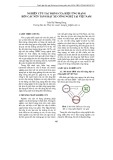


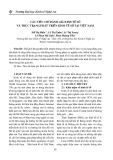
![Kinh tế số Việt Nam: Chính sách và thực thi [Cập nhật mới nhất]](https://cdn.tailieu.vn/images/document/thumbnail/2024/20241028/gaupanda058/135x160/4241730112118.jpg)
